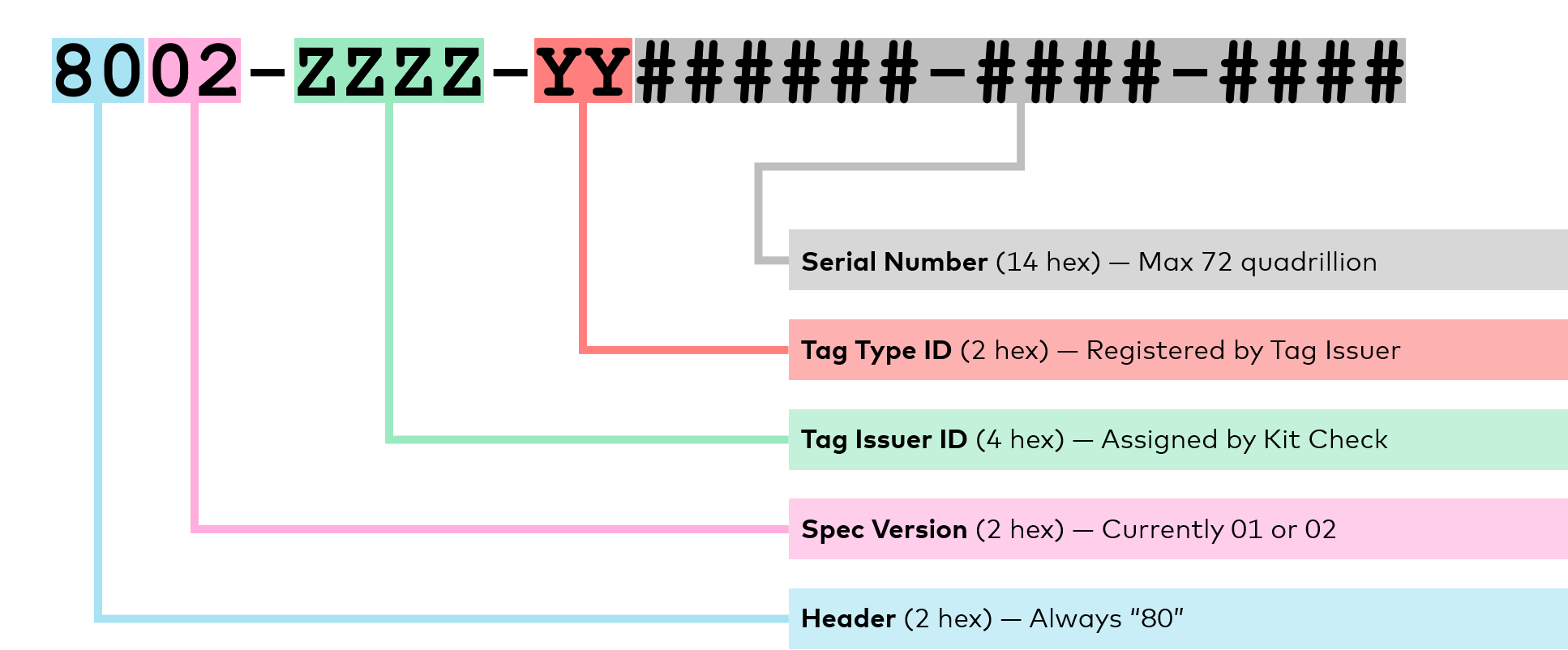EPC Length
Kit Check uses a 96-bit EPC.
Kit Check inlays have a 128 bit EPC memory bank, but Kit Check only uses a 96-bit EPC today.
The inlay uses “PC word” to define the EPC length. If PC word is 3000, then the EPC is 96-bit; if it’s 4000, the EPC would be 128-bit. In other words, if we write 96-bits to the inlay, then during subsequent reads, the chip tells the reader it only has 96-bit of info and return the 96-bit EPC.
EPC Schema
Kit Check currently supports two versions of EPC layouts.
- Version 1
- Originally launched in 2012
- Currently used by Kit Check’s Basic and Detailed tags, 503B compounders, and tagging service providers.
- These tags can be registered in Data Service, but not Registry.
- Version 2
- Originally launched in 2019
- Currently used by pharma manufacturers and any partner looking for cGMP compliance.
- These tags can be registered in Registry, but not Data Service.
Version 1

The Kit Check EPC v1 has 5 logical components, illustrated in the graphic above.
- Header
- Specifications Version
- Tag Issuer Code
- Tag Issuer Data
- Serial Number
Each character or position of the EPC is a hex character.
1. Header
This is always fixed with the hex characters 80.
2. Specifications Version
This defines which version of the EPC Layout Specifications (this document) governs the generation and interpretation of this EPC.
3. Tag Issuer Code
This is a 4-character hex code issued by Kit Check.
Each issuer code represents the party or business entity that generated the tag. In many cases, this is the same party that is associating that tag to a new item. But in the case that one party creates the tag and another party creates the item and associates it, the tag issuer will refer to the former.
Because the issuer code is scoped to a tag issuer, this allows for tag issuers to generate their own serial numbers, if they so choose, and guarantees that their numbers won’t collide with the serial numbers from other tag issuers.
4. Tag Issuer Data
This is a 2-character hex code that the tag issuer can choose to use for any purpose aside from serialization. This code should not be considered part of the item’s serial number.
This code may be used to represent item data or contain other information useful to business logic and operations. For example, a compounder with multiple facilities might choose to represent the facility in which this item was compounded.
In most cases, tag issuers should leave this blank by setting it to the hex characters 00.
5. Serial Number
This is the tag’s unique serial number, within the number-space scoped by the issuer ID.
For tag issuers that are requesting serial numbers from Kit Check, this will be the variable portion in the EPCs that we create for you.
For tag issuers that manage and generate their own serial numbers, this 14-character hex code is where you’ll incorporate your serial number into the overall EPC. This allows for approximately 72 quadrillion unique numbers.
NOTE: Please be careful about decimal-to-hexadecimal conversion. If you generate decimal serial numbers , you’ll need to convert them to hexadecimal and left-pad with zeros (for a total of 14 characters) before incorporating it into the overall EPC.
Version 2

The Kit Check EPC v2 has 5 logical components, illustrated in the graphic above.
- Header
- Specifications Version
- Tag Issuer Code
- Tag Type ID
- Serial Number
Each character or position of the EPC is a hex character.
1. Header
This is always fixed with the hex characters 80.
2. Specifications Version
This defines which version of the EPC Layout Specifications (this document) governs the generation and interpretation of this EPC.
3. Tag Issuer Code
This is a 4-character hex code issued by Kit Check.
Each issuer code represents the party or business entity that generated the tag. In many cases, this is the same party that is associating that tag to a new item. But in the case that one party creates the tag and another party creates the item and associates it, the tag issuer will refer to the former.
Because the issuer code is scoped to a tag issuer, this allows for tag issuers to generate their own serial numbers, if they so choose, and guarantees that their numbers won’t collide with the serial numbers from other tag issuers.
4. Tag Type ID
This is a 2-character hex code that the tag issuer must register with Kit Check. This code should not be considered part of the item’s serial number.
This code, in conjunction with the Tag Issuer ID, determines a number of attributes of the inlay and tag.
5. Serial Number
This is the tag’s unique serial number, within the number-space scoped by the issuer ID and tag type ID.
For tag issuers that are requesting serial numbers from Kit Check, this will be the variable portion in the EPCs that we create for you.
For tag issuers that manage and generate their own serial numbers, this 14-character hex code is where you’ll incorporate your serial number into the overall EPC. This allows for approximately 72 quadrillion unique numbers.
NOTE: Please be careful about decimal-to-hexadecimal conversion. If you generate decimal serial numbers , you’ll need to convert them to hexadecimal and left-pad with zeros (for a total of 14 characters) before incorporating it into the overall EPC.


